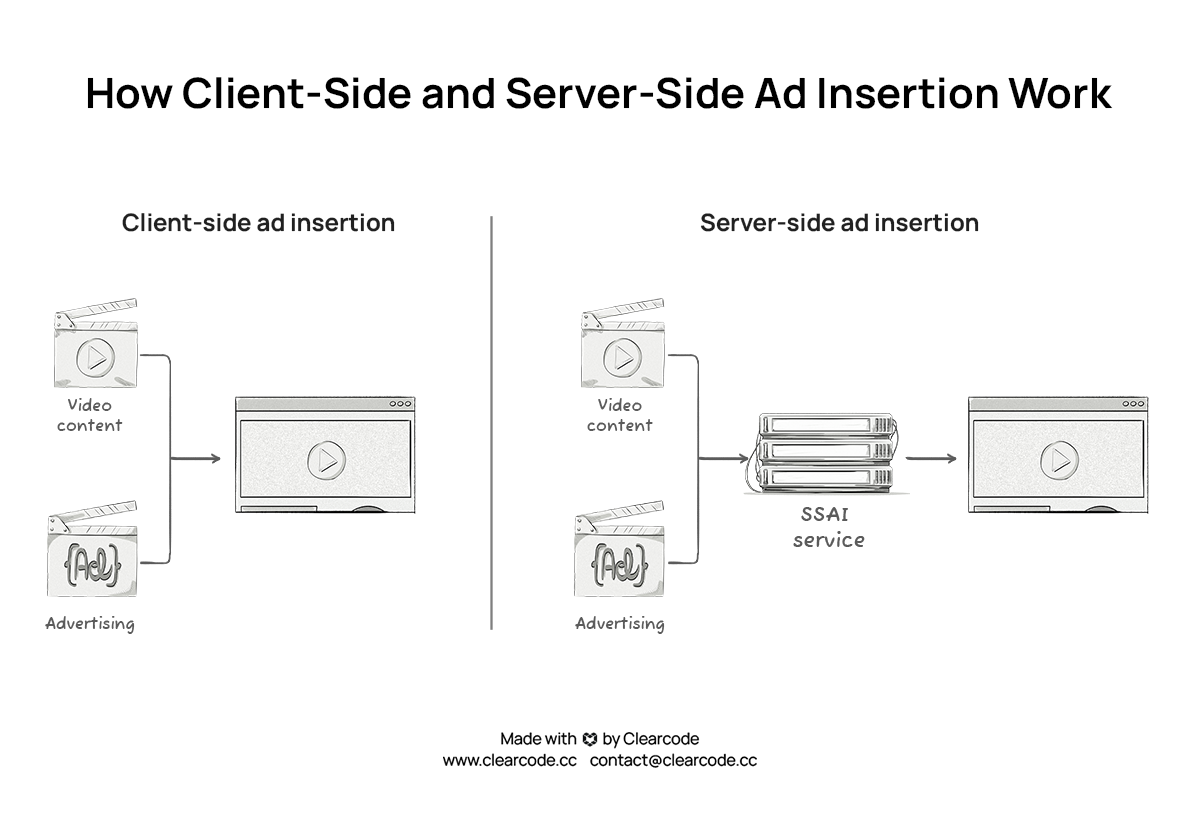With the video-streaming business expanding at a rapid pace and the streaming wars heating up — currently, the six leading video streaming service providers gather 777.6 million subscribers between them — it’s important to come up with brand new content, as well as make necessary improvements to ensure that the viewing experience is as seamless as possible.
Despite this huge expansion, many popular streaming services are facing a plateau or decrease in paid subscribers, so new content and platform features are a way to both attract new customers, as well as offer something fresh and exciting to those who are already subscribed.
That’s why streaming platforms are looking for ways to introduce advertising into the equation by offering a cheaper ad-supported plan.
When it comes to the delivery of ads in the connected TV (CTV) and over-the-top (OTT) video environments, there are 2 ways through which they can be inserted into the content: client-side ad insertion (CSAI) and server-side ad insertion (SSAI).
In this article, you will learn how they work, what the difference between them is, and when it’s best to use each of them.
Key Points
- Client-side ad insertion (CSAI) is a video ad-serving method whereby the video player requests an ad from an ad server via the video player located inside an application or website.
- Client-side ad insertion offers many advantages, including the ability to support various kinds of ads, be it skippable, clickable, or closable; track metrics for ad performance reporting, and show personalized ads to individual users.
- Server-side ad insertion (SSAI) is a video ad-serving method whereby the ads are stitched directly into the video content on the server side instead of the client application or video player, as is the case with client-side ad insertion (CCAI).
- The main advantages of server-side ad insertion are that it’s less susceptible to ad blockers and provides a better user experience as there isn’t ad buffering when displaying the ads.
The Rise of Advertising in Video-Streaming Services
Video advertising has always been seen as a premium medium as it allows brands to show engaging video ads to their target audience and allows publishers to receive a higher CPM compared to display ads.
It has also provided users with more choice over how they consume video content.
For those viewers who are unwilling to pay for an ad-free plan, whether they were previously subscribed or not, can still enjoy the content on the streaming service for a lower price.
For streaming services, it allows them to attract new subscribers and potentially convert them to the higher paid subscriptions, as well as generate additional revenue via advertising.
The primary revenue sources for streaming services are as follows:
- Subscription video on demand (SVOD) where the consumer pays a recurring fee to watch ad-free content.
- Ad-supported subscription is when the viewer can watch content for a fee with ads being shown at various times, e.g. before the content starts. The subscription fee to watch ad-supported content is cheaper than the ad-free subscription fee.
- Transactional video on demand (TVOD) is based on the pay-per-view model and can be further divided into electronic sell-through (EST), where you pay once to gain permanent access to a piece of content, and download to rent (DTR), where customers access a piece of content for a limited time for a smaller fee.
- Advertising video on demand (AVOD) is where the consumer can watch content containing ads without any fee.
We Can Help You Build a Connected TV (CTV) Ad Platform
Our AdTech development teams can work with you to design, build, and maintain a custom-built connected TV (CTV) ad platform for any programmatic advertising channel.
What Is Client-Side Ad Insertion (CSAI)?
Client-side ad insertion (CSAI) is a video ad-serving method whereby the video player requests an ad from an ad server via the video player located inside an application or website. When the ad server has received the ad request from the video player, it sends back an ad and displays it inside the video content.
With client-side ad insertion, it’s the client application and video player that are responsible for handling communication with the ad server. For example, the video player has to stop the video and make an API call to the ad server to request an ad. Once the ad has been displayed, the video player then resumes the video.
The actual advertisement that is displayed to users is selected based on the campaign’s criteria, which can include information relating to the user, publisher (e.g. website) and contents of the video.
The Main Advantages of Client-Side Ad Insertion
Here are just some of the main advantages of client-side ad insertion:
- It’s capable of supporting various kinds of ads, be it skippable, clickable, or closable.
- Tracking metrics for ad performance reporting is easy and very detailed, and provides a lot event data for ad-tracking services.
- Publishers and advertisers can use different ad formats, such as surveys, click-throughs, and overlays.
- It works with and without ad markers.
- Thanks to the advanced CSAI technology, it’s easy to offer highly personalized ads as data about the user and publisher can be used to determine which ad to display.
What Is Server-Side Ad Insertion (SSAI)?
Server-side ad insertion (SSAI) is a video ad-serving method whereby the ads are stitched directly into the video content on the server side instead of the client application or video player, as is the case with client-side ad insertion (CCAI).
It can be compared to traditional broadcast channel ad breaks as the transition from the video content to the ad break is smooth since the viewer isn’t waiting for the ad to load.
This makes it a continuous viewing experience with no pauses or breaks between the content and ads.
This method consists of various separate functionalities:
- Manifest manipulation — responsible for personalizing the video experience for every viewer.
- Ad server communication — used to communicate between the video server and ad server to deliver ads and collect data about the performance of the campaign, e.g. ad views.
- Ad bitrate with resolution normalization — bitrate is the number of bits of video information that is transmitted per second, either in kilobits/sec or megabits/sec.
Because SSAI is done on the server side, it works even for devices where inserting code might be difficult.
What’s crucial about this insertion method is that the client is not making calls to servers. Because of that, it’s harder to block ads inserted using SSAI.

The Main Advantages of Server-Side Ad Insertion
Here are some of the main advantages of server-side ad insertion:
- This ad insertion method is great for linear and live streams, or VOD, as the ad is stitched directly to the stream, making it less susceptible to ad-blocking software.
- Once the ads have been stitched into the video content, the video content and ads can then be used in an unlimited number of applications.
- Ads can be inserted over a linear slate, so no black screens.
- SDKs are not necessary thanks to codeless integration, so no regular code updates are required.
- SSAI offers high ad-fill rates and can generate more impressions, with the average completion rate for SSAI ads on live TV being 98%.
- Varying bandwidth conditions allow SSAI to effortlessly deliver a smooth playback experience, improving the streaming quality.
Now that we’ve talked about both CSAI and SSA, let’s compare these 2 ad insertion methods.
What’s the Difference Between Client-Side Ad Insertion and Server-Side Ad Insertion?
Ad Insertion
- With CSAI, ads are inserted into the video content via the video player.
- With SSAI, ads are stitched into the video content.
Ad Targeting
- Thanks to CSAI technology, a lot of highly personalized ads can be served,
- SSAI vendors are not that successful in that department, as they are met with massive drain on resources.
Measurement
- CSAI can offer rich tracking and metrics, as the process of setting up tracking is not complicated — VAST allows video players to report on video ad completion, clicks, click-throughs, etc.
- Believing an SSAI vendor that an ad was stitched into the stream doesn’t seem to be enough anymore, so there’s a demand for independent, client-side verification of this.
Viewer Experience
- When it comes to SSAI, communications for ad decisions and the actual ad stitching are performed by components upstream of client applications, providing a smooth playback experience.
- In CSAI, on the other hand, it’s done downstream by the video player and results in frame drop in video.
CSAI might have been more popular when it comes to streaming and over-the-top (OTT) ad delivery, but it has some challenges that are addressed by SSAI. That’s exactly why SSAI has been catching up to CSAI in the video-based ad monetization landscape and soon will become the superior option.
All in all, no matter which method you pick, both can provide ads that will be targeted and relevant to the viewer.
With that being said, they are way better than traditional broadcast channel ad slots, as you can never be completely sure who is watching and the audience data is most certainly not as precise.
We Can Help You Build a Connected TV (CTV) Ad Platform
Our AdTech development teams can work with you to design, build, and maintain a custom-built connected TV (CTV) ad platform for any programmatic advertising channel.








